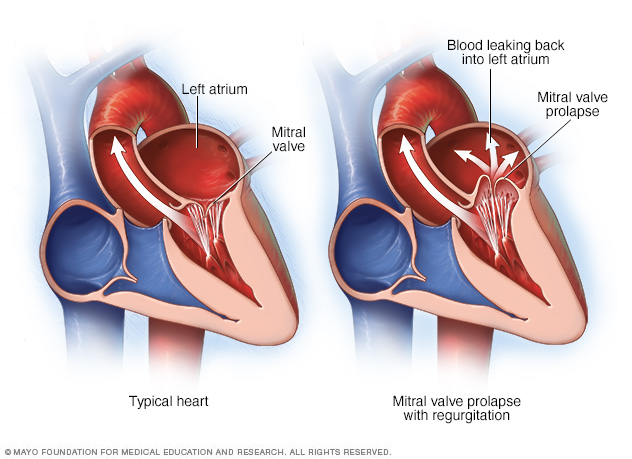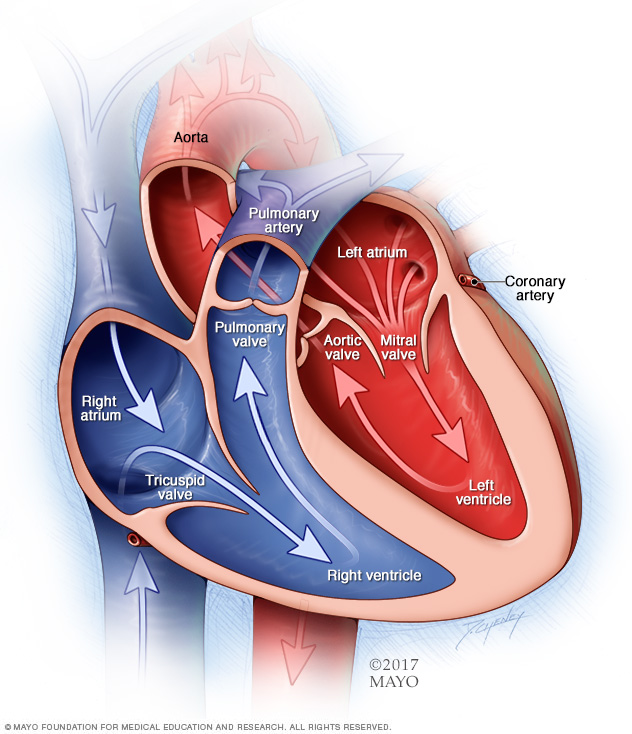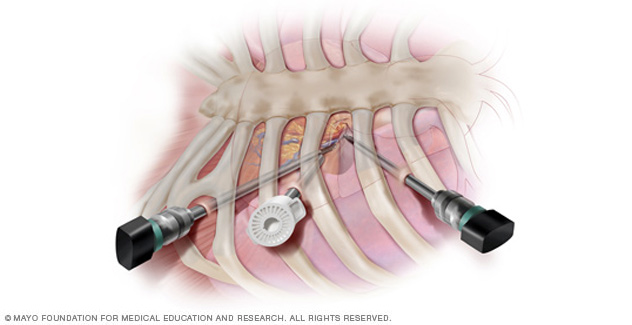Overview
Mitral valve disease is a problem with the valve located between the left heart chambers. The upper left heart chamber is called the left atrium. The bottom left heart chamber is called the left ventricle.
Mitral valve disease includes:
- Mitral valve regurgitation. The mitral valve flaps, also called leaflets, may not close tightly. This causes blood to leak backward.
- Mitral valve stenosis. The flaps of the mitral valve become thick or stiff, and they can fuse together. This narrows the valve opening, which reduces blood flow from the left atrium to the left ventricle.
Treatment for mitral valve disease depends on the severity of the condition and whether it is worsening. Sometimes, surgery is recommended to repair or replace the mitral valve.

Symptoms
Some people with mitral valve disease might not have symptoms for many years, if at all.
Symptoms of mitral valve disease can include:
- Fatigue.
- Irregular heartbeat.
- Shortness of breath.
When to see a doctor
If you have symptoms of mitral valve disease, you may be referred to a doctor trained in heart diseases, called a cardiologist.
Causes
To understand the causes of mitral valve disease, it may be helpful to know how the heart works.
The mitral valve is one of four valves in the heart that keep blood flowing in the right direction. Each valve has flaps, called leaflets, that open and close once during each heartbeat. If a valve doesn't open or close properly, blood flow through the heart to the body can be reduced.
- In mitral valve regurgitation, the flaps don't close tightly. Blood flows backward when the valve is closed, making it harder for the heart to work properly.
- In mitral valve stenosis, the valve opening narrows. The heart now must work harder to force blood through the smaller valve opening. If the opening in the valve becomes small enough, it can reduce blood flow between the left heart chambers.
Mitral valve disease has many causes. Some forms of mitral valve disease can be present at birth. A heart problem that you're born with is called a congenital heart defect.
Mitral valve disease also may develop later in life. This means it is acquired. For example, mitral valve stenosis is often caused by rheumatic fever. This fever is a complication of a strep infection that can affect the heart. When this happens, it's called rheumatic mitral valve disease.
Other causes of acquired mitral valve disease include:
- Other heart conditions.
- Infection.
- Age-related changes.
- Autoimmune disease, such as lupus.

Risk factors
Several things can increase the risk of mitral valve disease, including:
- Older age.
- Certain infections that affect the heart.
- Heart attack and some types of heart disease.
- Use of certain drugs.
- Heart condition present at birth, called a congenital heart defect.
- Radiation to the chest.
Complications
Mitral valve disease can cause many complications. Severe mitral valve regurgitation, for example, causes the heart to work harder, which can cause the left ventricle to enlarge and the heart muscle to weaken.
Other complications of mitral valve disease may include:
- Irregular and often rapid heartbeat, called atrial fibrillation.
- High blood pressure in the blood vessels in the lungs, called pulmonary hypertension.
- Blood clots.
- Congestive heart failure.
- Stroke.
Diagnosis
To diagnose mitral valve disease, including mitral valve stenosis and mitral valve regurgitation, a health care professional examines you and asks questions about your medical history.
The health care professional listens to your heart with a device called a stethoscope. A whooshing sound, called a heart murmur, may be a sign of a mitral valve condition.
Tests to diagnose mitral valve disease may include:
-
Echocardiogram. Sound waves are used to create pictures of the heart in motion. This test shows how blood moves through the heart and heart valves, including the mitral valve. An echocardiogram can help in the diagnosis of congenital mitral valve disease, rheumatic mitral valve disease and other heart valve conditions.
A standard echocardiogram is done from outside the body. But sometimes, a more-detailed echocardiogram is needed to get a closer look at the mitral valve. This type of echocardiogram is called a transesophageal echocardiogram. It is done from inside the body.
- Electrocardiogram (ECG or EKG). This quick and simple test measures the heart's electrical activity. It shows how fast or how slowly the heart is beating. Sticky patches called sensors or electrodes are attached to the chest and sometimes the arms and legs. Wires connect the patches to a computer, which prints or displays results.
- Chest X-ray. A chest X-ray is a picture of the heart and lungs. It can show whether the heart is enlarged, which can be a sign of certain types of heart valve disease.
- Cardiac MRI. This test uses magnetic fields and radio waves to create detailed pictures of the heart. A cardiac MRI might be done to determine the severity of mitral valve disease.
- Exercise tests or stress tests. These tests often involve walking on a treadmill or riding a stationary bike while the heart is checked. Exercise tests help reveal how the heart responds to physical activity and whether valve disease symptoms occur during exercise. If you can't exercise, you may get medicine that affects the heart like exercise does.
-
Cardiac catheterization. A doctor guides a thin tube called a catheter through a blood vessel to an artery in the heart. Dye flows through the catheter. This makes the heart arteries show up more clearly on an X-ray.
Cardiac catheterization isn't often used to diagnose mitral valve disease, but it may be used if other tests haven't diagnosed the condition. It also may be done to see if you have coronary artery disease.
Staging
After testing confirms a diagnosis of mitral or other heart valve disease, your health care team may tell you the stage of disease. Staging helps determine the most appropriate treatment.
The stage of heart valve disease depends on many things, including symptoms, disease severity, the structure of the valve or valves, and blood flow through the heart and lungs.
Heart valve disease is staged into four basic groups:
- Stage A: At risk. Risk factors for heart valve disease are present.
- Stage B: Progressive. Valve disease is mild or moderate. There are no heart valve symptoms.
- Stage C: Asymptomatic severe. There are no heart valve symptoms, but the valve disease is severe.
- Stage D: Symptomatic severe. Heart valve disease is severe and is causing symptoms.
Treatment
Mitral valve disease treatment depends on the symptoms, the severity of the condition, and whether the condition is worsening.
A doctor trained in heart disease, called a cardiologist, typically provides care for people with mitral valve disease. Treatment of mitral valve disease might include regular health checkups to see how well you're doing. If you have mitral valve disease, you might be asked to:
- Make healthy lifestyle changes.
- Take medicines to treat symptoms.
- Take blood thinners to reduce the risk of blood clots if you have an irregular heartbeat called atrial fibrillation.
Surgery or other procedures
A diseased or damaged mitral valve might eventually need to be repaired or replaced, even if you don't have symptoms. Surgery for mitral valve disease includes mitral valve repair and mitral valve replacement.
If you need surgery for another heart condition, a surgeon might do mitral valve repair or replacement at the same time.
Surgeons at some medical centers perform robot-assisted heart surgery, a type of minimally invasive heart surgery in which robotic arms are used to conduct the procedure.
Mitral valve repair
During mitral valve repair surgery, the surgeon might:
- Patch holes in a heart valve.
- Reconnect the valve flaps.
- Remove extra tissue from the valve so that the flaps can close tightly.
- Repair the structure of the mitral valve by replacing cords that support it.
- Separate valve leaflets that have fused.
Other mitral valve repair procedures include:
- Annuloplasty. A surgeon tightens or reinforces the ring around the valve. Annuloplasty may be done with other techniques to repair a heart valve.
- Valvuloplasty. This treatment is used to repair a mitral valve with a narrowed opening. Valvuloplasty might be done even if you don't have symptoms. The surgeon inserts a catheter with a balloon on the tip into an artery in the arm or groin and guides the catheter to the mitral valve. The balloon is inflated, widening the mitral valve opening. The balloon is deflated, and the catheter and balloon are removed.
- Mitral valve clip. In this treatment, a surgeon guides a catheter with a clip on its end to the mitral valve through an artery in the groin. The clip is used to fix a torn or leaky mitral valve leaflet. This procedure is an option for people who have severe mitral valve regurgitation or who aren't a good candidate for mitral valve surgery.
Mitral valve replacement
During mitral valve replacement, the heart surgeon removes the mitral valve and replaces it with a mechanical valve or a valve made from cow, pig or human heart tissue. A tissue valve is often called a biological tissue valve.
Sometimes, a heart catheter treatment may be done to insert a replacement valve into a biological tissue valve that is no longer working properly. This is called a valve-in-valve procedure.
If you had mitral valve replacement with a mechanical valve, you need blood thinners for life to prevent blood clots. Biological tissue valves break down over time and usually need to be replaced.

Lifestyle and home remedies
If you have heart valve disease, including mitral valve disease, it's important to follow a healthy lifestyle. Your health care team may tell you to make lifestyle changes, including:
- Eating a heart-healthy diet. Eat a variety of fruits and vegetables, low-fat or fat-free dairy products, poultry, fish, and whole grains. Avoid saturated and trans fat, and excess salt and sugar.
- Maintaining a healthy weight. Being overweight increases the risk of heart disease. Talk with a health care professional to set realistic goals for body mass index and weight.
- Getting regular physical activity. Aim to include about 30 minutes of physical activity, such as brisk walks, into your daily fitness routine. Talk to your health care team about the amount and type of exercise that's best for you, especially if you're considering competitive sports.
- Managing stress. Find ways to help manage your stress, such as through relaxation activities, meditation, physical activity, and spending time with family and friends.
- Avoiding tobacco. If you smoke, quit. Ask a health care professional about resources to help you quit smoking. Joining a support group may be helpful.
- Avoid or limit alcohol. Heavy alcohol use can cause irregular heartbeats. Ask your health care team about the effects of drinking alcohol.
- Get regular health checkups. Establish a regular schedule with your cardiologist or primary care doctor. Tell your health care team if you have any changes in your signs or symptoms.
- Practice good sleep habits. Poor sleep may increase the risk of heart disease and other chronic conditions. Go to bed and wake at the same time every day, including on weekends. If you have trouble sleeping, talk to a health care professional about strategies that might help.
Pregnancy
If you have mitral valve disease and are thinking about getting pregnant, talk to your health care team first. Pregnancy causes the heart to work harder. How a heart with mitral valve disease tolerates this extra work depends on many things. A health care professional also can explain how to safely treat mitral valve disease during pregnancy. Frequent health checkups are needed if you have heart valve disease during pregnancy.
Coping and support
Connecting with friends and family or a support group is a good way to reduce stress. You may find that talking about mitral valve disease and your concerns with others in similar situations can help.
Preparing for an appointment
If you think you have mitral valve disease, make an appointment for a health checkup. Here's some information to help you get ready for your appointment.
What you can do
- Be aware of pre-appointment restrictions. When you make the appointment, ask if there's anything you need to do beforehand.
- Write down your symptoms, including any that seem unrelated to mitral valve disease.
- Write down important personal information, including a family history of heart disease, and any major stresses or recent life changes.
- Make a list of all medications, vitamins and supplements you take. Include the dosages.
- Take a family member or friend along, if possible, to help you remember information you receive.
- Be prepared to discuss your diet and exercise habits. If you don't already eat well and exercise, be ready to talk about challenges you might face in getting started.
- Write down questions to ask your health care team.
For mitral valve disease, some basic questions to ask your health care team include:
- What is likely causing my symptoms or condition?
- What are other possible causes for my symptoms or condition?
- What tests will I need?
- What's the best treatment?
- What are the options to the main treatment you're suggesting?
- Is there a generic option to the medicine you're prescribing?
- I have other health conditions. How can I best manage them together?
- Are there restrictions I need to follow?
- Should I see a specialist?
- If I need surgery, which surgeon do you recommend for heart valve surgery?
- Are there brochures or other printed material I can take with me? What websites do you recommend?
Don't hesitate to ask other questions.
What to expect from your doctor
Your health care team is likely to ask you several questions, including:
- When did your symptoms begin?
- Have your symptoms been continuous or occasional?
- How severe are your symptoms?
- What, if anything, seems to improve your symptoms?
- What, if anything, appears to worsen your symptoms?
© 1998-2025 Mayo Foundation for Medical Education and Research (MFMER). All rights reserved. Terms of Use


